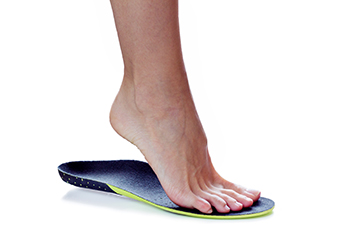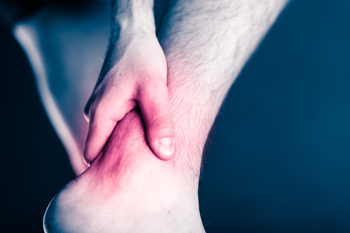Items filtered by date: April 2024
Common Foot Injuries in Baseball

Baseball players may experience various foot and ankle injuries, including contusions, fractures, heel spurs, and Achilles tendonitis. While these injuries can sideline even the most seasoned athletes, intervention from a podiatrist can make all the difference in swift recovery and long-term performance. Contusions are a common occurrence from ball contact or collisions among players. Sprains and fractures can occur during dynamic plays, such as sliding into a base, and require immediate medical attention. Catchers, who often bear the brunt of repetitive stress, can find relief from conditions such as plantar fasciitis and heel spur syndrome through custom orthotic devices and footwear recommendations provided by a podiatrist. By addressing issues like Achilles tendonitis with specialized care, including targeted stretching and strengthening programs, a podiatrist can help baseball players overcome injuries. If you incur a foot or ankle injury while playing baseball, it is suggested that you schedule an appointment with a podiatrist.
Sports related foot and ankle injuries require proper treatment before players can go back to their regular routines. For more information, contact one of our podiatrists of Premier Ankle & Foot Specialists. Our doctors can provide the care you need to keep you pain-free and on your feet.
Sports Related Foot and Ankle Injuries
Foot and ankle injuries are a common occurrence when it comes to athletes of any sport. While many athletes dismiss the initial aches and pains, the truth is that ignoring potential foot and ankle injuries can lead to serious problems. As athletes continue to place pressure and strain the area further, a mild injury can turn into something as serious as a rupture and may lead to a permanent disability. There are many factors that contribute to sports related foot and ankle injuries, which include failure to warm up properly, not providing support or wearing bad footwear. Common injuries and conditions athletes face, including:
- Plantar Fasciitis
- Plantar Fasciosis
- Achilles Tendinitis
- Achilles Tendon Rupture
- Ankle Sprains
Sports related injuries are commonly treated using the RICE method. This includes rest, applying ice to the injured area, compression and elevating the ankle. More serious sprains and injuries may require surgery, which could include arthroscopic and reconstructive surgery. Rehabilitation and therapy may also be required in order to get any recovering athlete to become fully functional again. Any unusual aches and pains an athlete sustains must be evaluated by a licensed, reputable medical professional.
If you have any questions please feel free to contact our offices located in South York, West York, and East York, PA . We offer the newest diagnostic and treatment technologies for all your foot and ankle needs.
Causes and Treatment of Supination

Understanding supination, also called underpronation, is essential for maintaining foot health. Supination occurs when your weight rolls onto the outer edges of the feet during movement. It is often the result of inherited structural issues or muscle weakness. Unfortunately, excessive supination can lead to various problems, including back and hip pain, knee stress, ankle injuries, and plantar fasciitis. Supination can also cause tension in different parts of the body over time, increasing the risk of injuries. Seeking medical help from a podiatrist for a gait analysis is advisable if you suspect supination, or are experiencing unexplained lower body pain. Treatment typically involves corrective measures to address foot alignment and prevent future injuries. This may include selecting appropriate footwear with extra cushioning and room in the toes, using custom-made orthotic insoles, and performing strength and stretching exercises as suggested by a podiatrist. Proper care and intervention can alleviate discomfort and prevent complications associated with supination, ensuring optimal mobility and well-being. If you believe you have pain that results from supination, it is suggested that you schedule an appointment with a podiatrist.
If you have any concerns about your feet, contact one of our podiatrists from Premier Ankle & Foot Specialists. Our doctors can provide the care you need to keep you pain-free and on your feet.
Biomechanics in Podiatry
Podiatric biomechanics is a particular sector of specialty podiatry with licensed practitioners who are trained to diagnose and treat conditions affecting the foot, ankle and lower leg. Biomechanics deals with the forces that act against the body, causing an interference with the biological structures. It focuses on the movement of the ankle, the foot and the forces that interact with them.
A History of Biomechanics
- Biomechanics dates back to the BC era in Egypt where evidence of professional foot care has been recorded.
- In 1974, biomechanics gained a higher profile from the studies of Merton Root, who claimed that by changing or controlling the forces between the ankle and the foot, corrections or conditions could be implemented to gain strength and coordination in the area.
Modern technological improvements are based on past theories and therapeutic processes that provide a better understanding of podiatric concepts for biomechanics. Computers can provide accurate information about the forces and patterns of the feet and lower legs.
Understanding biomechanics of the feet can help improve and eliminate pain, stopping further stress to the foot.
If you have any questions please feel free to contact our offices located in South York, West York, and East York, PA . We offer the newest diagnostic and treatment technologies for all your foot and ankle needs.
Custom Orthotics Seasonal - Any Season

Rain or shine, snow or sleet, Custom Orthotics have your feet covered! As the seasons change, ensure your steps remain comfortable and supported. Custom Orthotics adapt to your footwear, from summer sandals to winter boots, providing consistent relief and alignment. Don't let the changing weather dictate your foot comfort. Step confidently year-round and experience the difference with Custom Orthotics. Call today for more information.
Managing Heel Pain

Heel pain affects many people due to the daily strain placed on their feet. While often attributed to heel spurs, the primary culprit is usually plantar fasciitis. Neglecting the intricate network of muscles in the feet can negatively affect any existing issues or cause new ones. Engaging in foot exercises to restore muscle length and enhance overall body balance can significantly alleviate heel pain. Also, the choice of footwear plays a pivotal role in foot health. Wearing worn out or unsupportive shoes can disrupt natural foot mechanics, leading to discomfort and potential injury. Regularly inspecting footwear, especially those used for physical activity, may help to decrease the risk of heel pain. Opt for shoes that provide adequate cushioning, support, and stability that helps maintain proper foot alignment. When heel pain persists despite these measures, seeking professional guidance from a podiatrist is imperative. This type of doctor can conduct a thorough evaluation to identify the root cause of the discomfort and develop a personalized treatment plan. Custom orthotics may be prescribed as a way to regain comfort and mobility. It is suggested that you schedule an appointment with a podiatrist to manage heel pain.
Many people suffer from bouts of heel pain. For more information, contact one of our podiatrists of Premier Ankle & Foot Specialists. Our doctors can provide the care you need to keep you pain-free and on your feet.
Causes of Heel Pain
Heel pain is often associated with plantar fasciitis. The plantar fascia is a band of tissues that extends along the bottom of the foot. A rip or tear in this ligament can cause inflammation of the tissue.
Achilles tendonitis is another cause of heel pain. Inflammation of the Achilles tendon will cause pain from fractures and muscle tearing. Lack of flexibility is also another symptom.
Heel spurs are another cause of pain. When the tissues of the plantar fascia undergo a great deal of stress, it can lead to ligament separation from the heel bone, causing heel spurs.
Why Might Heel Pain Occur?
- Wearing ill-fitting shoes
- Wearing non-supportive shoes
- Weight change
- Excessive running
Treatments
Heel pain should be treated as soon as possible for immediate results. Keeping your feet in a stress-free environment will help. If you suffer from Achilles tendonitis or plantar fasciitis, applying ice will reduce the swelling. Stretching before an exercise like running will help the muscles. Using all these tips will help make heel pain a condition of the past.
If you have any questions please contact our offices located in South York, West York, and East York, PA . We offer the newest diagnostic and treatment technologies for all your foot and ankle needs.
The Role of Orthotics in Addressing Injuries

Foot orthotics are invaluable tools in addressing a range of foot and lower limb issues, from soft tissue injuries to neurological changes and bony injuries. These custom shoe inserts provide support, stability, and alignment, aiding in the rehabilitation and prevention of various conditions. For soft tissue injuries like plantar fasciitis, orthotics can alleviate strain by redistributing pressure and providing cushioning. In cases of bone injury such as stress fractures, orthotics can offer support and minimize excessive motion that could exacerbate the injury. Additionally, for individuals experiencing neurological changes like drop foot, orthotics can assist in maintaining proper foot position and facilitating a more natural gait pattern. The decision on the type of orthotic needed involves a thorough assessment of the individual's impairments, functional goals, and injury protection requirements. Factors such as foot structure, biomechanics, activity level, and footwear preferences are considered to tailor orthotics specifically to the individual's needs, ensuring optimal support and rehabilitation. If you have persistent foot problems or injuries, it is suggested that you make an appointment with a podiatrist to see if custom-made orthotics can help you.
The benefits of custom orthotics are far-reaching and can make a significant impact on your daily life. Whether you are an athlete looking to enhance your performance, a healthcare worker on your feet every day, someone who experiences chronic foot pain, or someone who wants to improve their overall comfort and well-being, custom orthotics can be a game changer.
Custom orthotics provide support, stability, and relief for a variety of foot conditions ranging from flat feet to heel pain. They can even help prevent injuries and address more severe foot concerns, such as plantar fasciitis and diabetic foot issues.
Contact one of our podiatrists at Premier Ankle & Foot Specialists to create tailored orthotics for you and enjoy a higher quality of life, reduced pain, and increased mobility. With the right orthotics, you can continue doing the things you love, whether it’s running, dancing, or simply walking comfortably without discomfort.
If you are suffering from foot discomfort or have concerns about your foot health, do not hesitate to contact one of our podiatrists at Premier Ankle & Foot Specialists to explore the benefits of orthotics for you. Your feet are the foundation of your body and investing in their well-being can lead to a happier, healthier, and more active lifestyle. Your feet will thank you!
If you have any questions please contact our offices located in South York, West York, and East York, PA . We offer the newest diagnostic and treatment technologies for all your foot and ankle needs.
Treatment Options for Achilles Tendon Pain

Treatment for Achilles tendon pain involves a comprehensive approach to alleviate discomfort and promote healing. Short-term use of non-steroidal anti-inflammatory drugs, NSAIDs, under medical supervision can provide relief from Achilles tendon pain. Incorporating warm-up exercises, stretching, and resistance training to strengthen the lower leg muscles and improve tendon function may be prescribed. Orthotic devices such as shoe inserts can help to redistribute pressure away from the Achilles tendon and facilitate healing. Surgical intervention is reserved for cases where conservative treatments have failed, involving procedures such as tendon removal or reattachment. For a personalized treatment plan to treat Achilles tendon pain, it is suggested that you schedule an appointment with a podiatrist.
Achilles tendon injuries need immediate attention to avoid future complications. If you have any concerns, contact one of our podiatrists of Premier Ankle & Foot Specialists. Our doctors can provide the care you need to keep you pain-free and on your feet.
What Is the Achilles Tendon?
The Achilles tendon is a tendon that connects the lower leg muscles and calf to the heel of the foot. It is the strongest tendon in the human body and is essential for making movement possible. Because this tendon is such an integral part of the body, any injuries to it can create immense difficulties and should immediately be presented to a doctor.
What Are the Symptoms of an Achilles Tendon Injury?
There are various types of injuries that can affect the Achilles tendon. The two most common injuries are Achilles tendinitis and ruptures of the tendon.
Achilles Tendinitis Symptoms
- Inflammation
- Dull to severe pain
- Increased blood flow to the tendon
- Thickening of the tendon
Rupture Symptoms
- Extreme pain and swelling in the foot
- Total immobility
Treatment and Prevention
Achilles tendon injuries are diagnosed by a thorough physical evaluation, which can include an MRI. Treatment involves rest, physical therapy, and in some cases, surgery. However, various preventative measures can be taken to avoid these injuries, such as:
- Thorough stretching of the tendon before and after exercise
- Strengthening exercises like calf raises, squats, leg curls, leg extensions, leg raises, lunges, and leg presses
If you have any questions please feel free to contact our offices located in South York, West York, and East York, PA . We offer the newest diagnostic tools and technology to treat your foot and ankle needs.
Exploring Varieties of Foot and Toe Fractures

Foot and toe fractures, encompass diverse types, each presenting unique characteristics and considerations for treatment. Spiral fractures, often seen in sports injuries or severe trauma, involve a twisting force that causes the bone to break in a spiral pattern along its length. Internal metatarsal fractures occur within the long bones of the foot, typically resulting from direct impact or excessive stress. These fractures may affect multiple metatarsals and often require careful assessment to detect subtle injuries. Fifth metatarsal fractures, known as Jones fractures, occur at the base of the fifth metatarsal, typically due to sudden twisting motions or overuse. These fractures can be challenging to heal due to limited blood supply in the area. Prompt diagnosis and appropriate treatment, including immobilization, rest, and possibly surgical intervention, are essential for optimal recovery and prevention of long-term complications. If you have fractured your toe or foot bones, it is suggested that you speak with a podiatrist who can offer the correct treatment for the type of fracture you have.
A broken foot requires immediate medical attention and treatment. If you need your feet checked, contact one of our podiatrists from Premier Ankle & Foot Specialists. Our doctors can provide the care you need to keep you pain-free and on your feet.
Broken Foot Causes, Symptoms, and Treatment
A broken foot is caused by one of the bones in the foot typically breaking when bended, crushed, or stretched beyond its natural capabilities. Usually the location of the fracture indicates how the break occurred, whether it was through an object, fall, or any other type of injury.
Common Symptoms of Broken Feet:
- Bruising
- Pain
- Redness
- Swelling
- Blue in color
- Numbness
- Cold
- Misshapen
- Cuts
- Deformities
Those that suspect they have a broken foot shoot seek urgent medical attention where a medical professional could diagnose the severity.
Treatment for broken bones varies depending on the cause, severity and location. Some will require the use of splints, casts or crutches while others could even involve surgery to repair the broken bones. Personal care includes the use of ice and keeping the foot stabilized and elevated.
If you have any questions please feel free to contact our offices located in South York, West York, and East York, PA . We offer the newest diagnostic and treatment technologies for all your foot and ankle needs.
